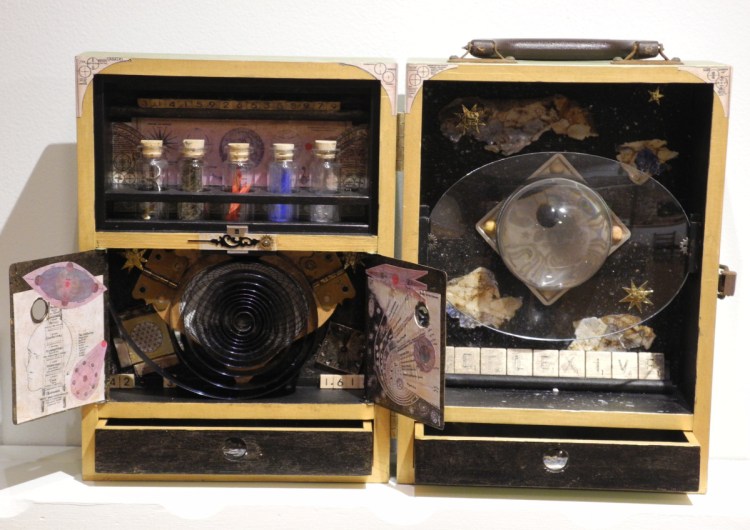When we think of the art of assemblage, particularly boxed assemblages, Joseph Cornell (1903-1972) immediately comes to mind. Cornell almost is to shadow boxes what Alexander Calder is to mobiles. And however many artists follow in Cornell’s wake, and however much they seek to emulate him, his work is still always instantly recognizable.
On view now at the Metropolitan Museum of Art is “Birds of a Feather,” an exhibition of Cornell’s work dedicated to a single cubist collage painting by Juan Gris, “The Man at the Café” (1914), a promised gift to the museum as part of the Leonard A. Lauder Cubist Collection. The show not only reveals Cornell’s depth and nuance on a focused subject, but it reminds us how artists inspire each other.
Cornell’s boxes in “Birds” all share a similar format and iconography (notably, a white cockatoo) and yet what seems to have thrilled Cornell about “The Man at the Café” was the fact the painting’s surface was mostly filled with text-covered paper. Cornell is a giant, and he set an almost bizarrely high standard for Mae Billington’s surrealism-inspired boxes, in her show up at Green Lion Gallery in Bath, but in the end, his recognizable quirk sets him apart enough that there is space for others to work in a similar vein without coming across as copying him.
“Birds” reminded me of Billington’s show, “Untold Stories,” for several reasons. The obvious connection is the direct relationship of Billington’s assemblage practice to that of Cornell, who casts a giant shadow on the show. Also, Green Lion Gallery is a print gallery, and the primary image of “Birds” is a leitmotif of a cockatoo quite literally taken by Cornell from a 19th-century print.

“Curing”
Billington’s show is a new direction for Green Lion. The gallery focuses primarily on prints and works on paper, but it has had some excellent painting shows, such as one by Chris Beneman. (Two of her blue harbor paintings are still on view.) Some of Billington’s assemblages are wall pieces, while others are free-standing sculptures. They generally follow the logic of surrealism; their leading intent seems to be the uncanny, the fascinatingly odd. Billington’s leading aesthetic is that of clockwork. This has a double effect. On one hand, it plays up a sense of jewelry scale and detail. But it also hints of automatons, the very model of uncanny, according to Freud (who looked to ETA Hoffmann, the proto-surrealist author of odd texts like “The Nutcracker”).
“Curing,” for example, is a doll-sized standing figure, a mini mannequin. It wears a pink dress and has a clock face for a face. It reaches out with scissors to cut its own hair, a writhing mass of springs and monofilament. This where the title comes in: Curing, in food preparation, is about timing and patience; curing a disease by taking something sharp to your head, well, that’s something else entirely.
“The 11th Hour” is a very old and decrepit mannequin hand in a bell jar. As its paint/skin peels, we see its clockwork interior revealed.

“The 11th Hour”
The first work in “Untold Stories” is a folding box, a clear tilt of the hat to Cornell. It’s like a portable alchemy kit. On one side is a row of corked bottles with different colored materials in them. Again, there are clock springs. There are a few bits of illustrated text collaged into the box; these hint at arcane ideas that float between alchemy, the occult, Buddhism and so on. The number “1618” and the word “reflexive” are spelled out in Scrabble letters. It’s a complex object, packed with clues, and yet it remains decidedly silent. Maybe it could all be unpacked with the information we have at hand, but Billington rather clearly presents the symbols as esoteric. So, like alchemy, it would take work and research to go deep where, quite possibly, you would find nothing at all.
The idea of appropriating or collaging prints – whether by Cornell or Billington – is intriguing. Even the prints of gallery owner David Morgan borrow Celtic designs. But to cut up a book or a print is an extraordinary practice that, at some point, we came to see as normal. (Collage was invented by the Cubists, and so the 1914 Gris that fascinated Cornell was an early example.)
Appropriation is a fascinating and complex subject. Much of the work in the Portland Museum of Art’s Biennial, for example, relies on different forms of appropriation: Daniel Minter includes, among other things, found artifacts in his giant painting installation; DM Witman borrows (beautiful) satellite images to consider climate change; Rosamund Purcell’s work presents mysteriously historic objects, books and artifacts; Shaun Leonardo and Elise Ansel borrow and re-present important images; and Gina Adams’s work is based on broken treaties presented on appropriated handmade quilts.
Appropriation of objects in art can be used to think in terms of traces. This was Freud’s great insight about psychology: the tracking of subconscious traces. The Surrealists were directly influenced by Freud and they sought to activate subconscious energy with their work. Other types of appropriation are used by artists to convene historical or moral conversations. Traces and evidence, after all, are not only method points of doctors, but detectives and the judicial system as well. Billington’s work belongs the first type, while the identity-oriented work on view the PMA Biennial belongs largely to this second, moral mode.
Green Lion has presented itself as an excellent print gallery over the past couple of years. With Billington, it’s taking a new step. I am interested to see what the gallery does moving forward.
Freelance writer Daniel Kany is an art historian who lives in Cumberland. He can be contacted at:
dankany@gmail.com
Send questions/comments to the editors.



Comments are no longer available on this story